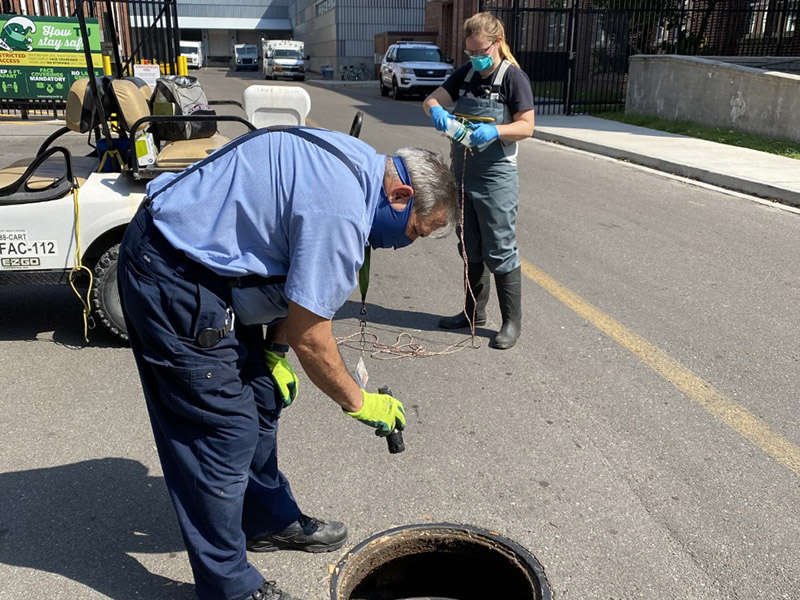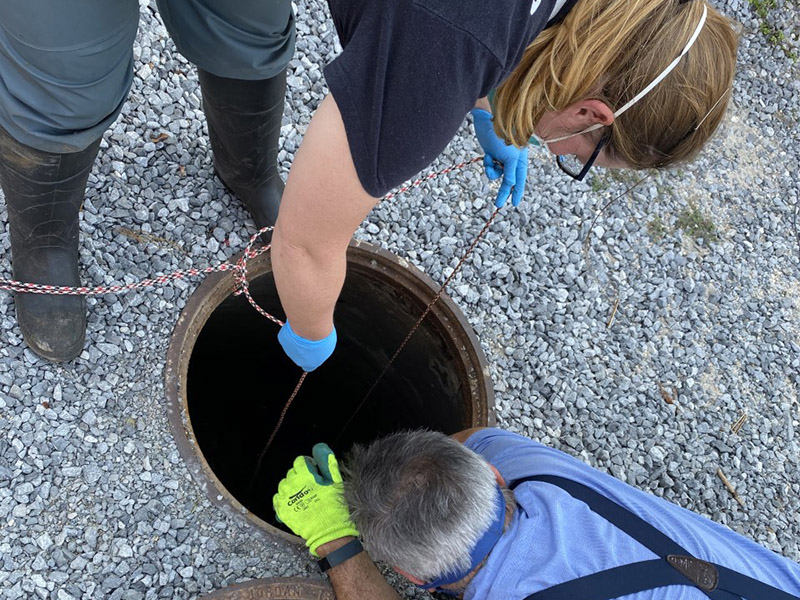Since it’s known that viral RNA is shed through feces, even in asymptomatic individuals, the best way to head off COVID-19 outbreaks in New Orleans and elsewhere might just prove to be its waste. Or, as Samendra Sherchan, PhD, assistant professor in the School of Public Health and Tropical Medicine’s Department of Environmental Health Sciences puts it: “Poop never lies!”
Environmental surveillance, the monitoring of wastewater and sewage to reveal information about a community’s health, isn’t new. It’s a midcentury invention, a powerful tool that has been used to track emerging viruses, vaccine adherence, antibiotic-resistant genes, illicit drug use, and pathogens that might signal a bioterrorism attack. Researchers can apply it to a large area such as an entire parish, or a smaller one, such as a neighborhood or campus—even a specific building. But the current pandemic is the first time it’s being used as an advance warning system.
“It’s taking another step, utilizing it for public health officials to make better decisions in controlling and mitigating COVID-19,” says Dr. Sherchan. Together with Tiong Gim Aw, PhD, assistant professor in the Department of EHS, and six colleagues, Dr. Sherchan published a paper[SZ1] on what they believe was the first detection of coronavirus-2 RNA in wastewater in the United States, which they achieved using two reverse transcription-quantitative polymerase chain reaction (RT-qPCR) assays. The resulting information is “at least four to seven days ahead of COVID-19 infection because with clinical testing you have lags, and people might not have symptoms. Before the clinical cases start to appear in the community, you already have positive detection in wastewater,” says Dr. Sherchan.
One recent example of successful surveillance was at the University of Arizona, which stopped a late-August outbreak in a dorm after wastewater testing showed RNA from SARS-CoV-2—even though all 311 residents and workers had tested negative days earlier. On retesting, two students were found to have COVID, though neither showed symptoms. People who went to a bar in June in East Lansing, home to Michigan State University, were not so fortunate. That so-called super spreader event would result in no fewer than 200 infections; researchers discovered that virus levels had spiked in the area’s wastewater just a few days earlier.
Dr. Aw, who happened to spend the summer at Michigan State, says that although environmental surveillance is a broad, nationwide—even global—effort, labs and universities are collaborating and sharing protocols. Because wastewater surveillance for coronavirus is an emerging field, “having standardized methods in terms of collection and detection is critical and will be our ultimate goal moving forward.” As of now, SPHTM teams are processing 100 to 200 milliliters of raw sewage at a go, using whichever molecular method they’re most comfortable with, and Dr. Sherchan says optimizing sample collection and molecular assays for viral detection is another universal goal.
Surveillance isn’t only used to head off outbreaks, and sometimes researchers don’t want such granular information. Tracking wastewater in a broader area will give different data, even if it wouldn’t have been useful in targeted sites such as the Arizona dorm.

“If you’re sampling an entire parish, the kind of answers you get are not for that kind of use. You’re not going to go back and test everybody in the parish,” says Chair of Tropical Medicine Ronald Blanton, MD, MS. “If we do an intervention like start using masks or closing bars, or give a vaccine, [we can gauge] what’s the response like compared to what it was a week ago or a month ago. It’s asking a different kind of question, and the response is going to be different.” That’s the approach Dr. Aw is taking in monitoring the wastewater treatment plants for New Orleans and Kenner on a weekly basis.
“We have been communicating with the health departments, and they use this as one of the surveillance tools to decide whether or not to reopen the city, or to implement more stringent restrictions,” he says. Some areas in the city are so old that it would be challenging to pinpoint sampling locations, as is the case on Tulane’s campus. Dr. Aw gives a nod to the university for its robust clinical testing protocol, noting that some undergraduates are tested as often as twice a week. Environmental surveillance, agrees Dr. Sherchan, “is a complement to clinical testing—it’s not going to replace clinical testing per se.”
In addition, variables can affect a specific collection, and data values may change over time.
“The sewer systems are arranged so there are collection points that represent everything that comes out of a neighborhood, and then they all flow together and get collected at the wastewater plant,” says Dr. Blanton. “More refined data means more sampling, and that becomes more expensive. The other issue is what you’re sampling. Some wastewater is combined with the sanitary sewer as well as runoff, so on a rainy day you’ll get a whole lot of dilution of that sample.” Community water usage can likewise affect results.
SPHTM wastewater researchers are also interested in addressing COVID-related public health issues beyond U.S. borders. They’re awaiting word on funding to look at waste in low-resource countries—specifically, Nepal and Brazil, which both have significant levels of raw sewage in surface waters—in part because less-developed nations often lack resources to implement clinical testing. They’ve also applied for NIH grants that would allow them to watch for active virus rather than just RNA in wastewater systems around the region, as well as focus on viral detection in hotspots such as airports, nursing homes, prisons, and university dorms.
And long after the threat of COVID is diminished, they expect environmental surveillance will have a place as a key tool in the early detection of diseases such as hepatitis A and B, rotavirus, and noroviruses that lurk in wastewater.
[SZ1]https://pubmed.ncbi.nlm.nih.gov/32758821/#affiliation-6

